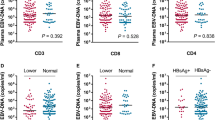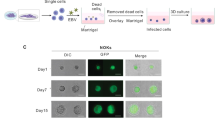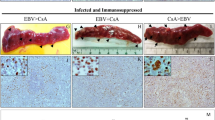Abstract
Clonal expansion of Epstein-Barr virus (EBV) infected B-cells occasionally occurs in immunocompromized subjects. EBV-infected T/natural killer (NK)-cells proliferate in patients with chronic active EBV infection (CAEBV) that is a rare mononucleosis syndrome. It is classified into either T-cell type or NK-cell type according to the primary target of infection, while the pathogenesis remains unclear. To search the clonal origin of EBV-infected T/NK-cells, virus distribution and clonotype were assessed by using highly purified cell fractions obtained from 6 patients. Patient 1 had a monoclonal proliferation of EBV-infected T-cell receptor V&x03B4;2/V&x03B3;9-expressing cells, and carried lower copy number of EBV in &x03B1;&x03B2;T-cells. Patients 2 and 3 had a clonal expansion of EBV-infected CD4+T-cells, and lower EBV load in CD56+cells. Patients 4, 5 and 6 had an expansion of CD56+cells with higher EBV load than CD3+cells. EBV-terminal repeats were determined as clonal bands in the minor targeted populations of 5 patients. The size of terminal repeats indicated the same clonotype in minor subsets as in major subsets of 4 patients. However, EBV was not detected in bone marrow-derived lineage negative CD34+cells of patients. These results suggested that EBV could infect T/NK-cells at differentiation stage, but spared bone marrow CD34+hematopoietic stem cells in CAEBV patients.
Similar content being viewed by others
Article PDF
Author information
Authors and Affiliations
Corresponding author
Rights and permissions
About this article
Cite this article
Ohga, S., Ishimura, M., Toshimoto, G. et al. Clonal origin of Epstein-Barr virus-infected T/NK-cell subpopulations in chronic active Epstein-Barr virus infection. Nat Prec (2010). https://doi.org/10.1038/npre.2010.4238.1
Received:
Accepted:
Published:
DOI: https://doi.org/10.1038/npre.2010.4238.1



